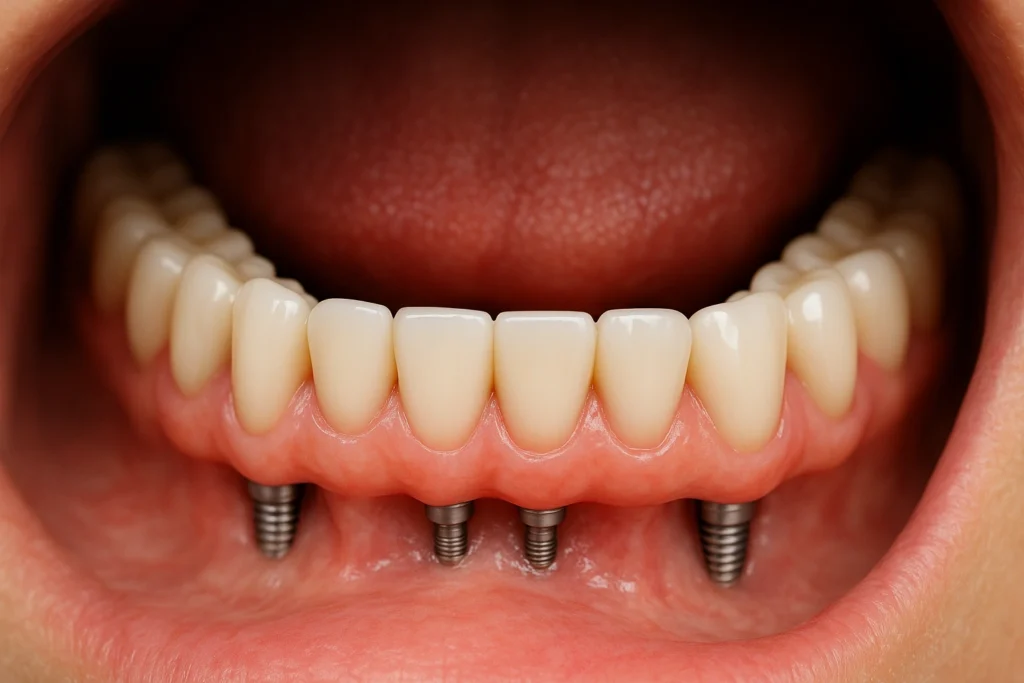If you’ve ever worried about dentures slipping at the worst possible time, or you’ve struggled with missing teeth making it hard to eat your favorite foods, you’re not alone. Many people face the daily frustration of unstable dentures or gaps in their smile. Here’s the thing: modern dentistry has given us a powerful solution called the All on Four bridge.
Think of it like this: instead of replacing every missing tooth with an individual implant, dentists can place just four implants in the jaw and use them to support a full arch of teeth. It’s a clever design that gives you fixed, natural-looking teeth in a shorter amount of time, and often without the need for complicated bone grafts.
In short defination:
An All on Four bridge is a fixed full-arch dental solution that uses four implants to support a permanent bridge, giving patients stable, natural-looking teeth without the hassle of dentures.
In this guide, we’ll walk through what an All on Four bridge really is, why it’s so popular, what it costs, who it’s for, and what it feels like to go through the process. I’ll also share expert-backed insights and some real-world tips from patients who’ve been through it, so you can decide if this might be the solution you’ve been looking for.
What is an All on Four Bridge?
The All on Four bridge is exactly what it sounds like: a dental bridge that replaces an entire arch of teeth, supported by just four dental implants. Here’s how it works: two implants are placed toward the front of the jaw, and two are angled in the back. This clever placement makes the most of your existing bone and usually avoids the need for bone grafting.
If you’re wondering why this matters, it’s because bone grafting can add months (and a lot of cost) to the implant process. By tilting the back implants, dentists can anchor the bridge securely even if your bone has thinned over the years. It’s a design that’s both practical and highly effective.
Now, how’s this different from a traditional dental bridge or dentures? A regular bridge typically replaces just a few teeth and depends on natural teeth for support. Dentures, on the other hand, rest on your gums and can move around. The All on Four bridge is in a league of its own: it’s fixed in place, doesn’t slip, and feels much closer to having your natural teeth back.
Here’s the best part: in many cases, you can walk into a clinic with no teeth and walk out the same day with a full set of fixed, beautiful teeth. This is often called “Teeth in a Day,” and it’s one of the biggest reasons patients love this treatment.
Key Benefits of Choosing an All on Four Bridge
So, why are so many people choosing the All on Four bridge over traditional dentures or multiple implants? Let’s break down the main benefits.
1. Stability and Confidence
If you’ve ever had dentures that slip while eating or speaking, you’ll understand how life-changing stability can be. With the All on Four system, your teeth are anchored to implants, so they stay put. You can eat an apple, laugh loudly, or talk with friends without worrying about movement.
2. Fewer Implants, Less Surgery
Here’s the thing: replacing every single tooth with its own implant isn’t always realistic. It would take a lot of surgery, healing, and money. The All on Four approach uses just four implants per arch, which means less invasive surgery and a quicker recovery. On top of that, most patients don’t need bone grafts because of the angled placement of the implants.
3. Faster Results
Traditional implants can take months before you get your final teeth. With All on Four, many patients leave the clinic the same day with a fixed temporary bridge. Imagine walking in with no teeth and walking out with a full smile—that’s powerful.
4. Natural Look and Feel
The bridges are custom-made to match your face and smile. Patients often say their new teeth look and feel just like natural ones. And because the bridge is anchored, chewing feels solid and reliable again.
5. Long-Term Success
Studies have shown high survival rates for All on Four implants over 10+ years. In plain words: this isn’t just a quick fix, it’s a long-term solution when done right by an experienced dentist.
Materials and Types of All on Four Bridges
Not all All on Four bridges are created equal. The materials used can make a big difference in how your new teeth look, feel, and last over time. Let’s go over the main options.
Acrylic vs Zirconia
Most temporary bridges are made from acrylic because it’s lightweight and easy to adjust. But here’s the thing: acrylic can wear down over time. Zirconia, on the other hand, is incredibly strong and looks more like natural enamel. Many patients eventually upgrade to a zirconia bridge for better durability and aesthetics. Of course, zirconia comes at a higher price, so it really depends on your budget and priorities.
Porcelain Bridges
Porcelain has been a gold standard in dental aesthetics for decades. A porcelain All on 4 bridge can mimic the light reflection and translucency of natural teeth beautifully. The downside? It’s more fragile than zirconia and often more expensive.
Hybrid Options
Some bridges combine a titanium or metal bar inside for strength, layered with acrylic or zirconia on top for looks. These “hybrid” bridges strike a balance between strength, cost, and aesthetics.
What This Means for You
If you’re the kind of person who wants the strongest, longest-lasting solution, zirconia might be your pick. If you’re more concerned with budget and short-term results, acrylic could be a good start. Porcelain offers beautiful aesthetics but may need more care. The choice often comes down to your lifestyle, habits, and how much you’re ready to invest in your smile.
Costs and Pricing Breakdown
Now, let’s talk about one of the biggest questions patients have: how much does an All on Four bridge cost?
Here’s the honest truth: the price can vary a lot depending on where you live, what materials you choose, and your dentist’s experience. But to give you a ballpark:
- All-on-4 dental implants cost in the U.S.: $20,000 to $30,000 per arch
- All on 4 zirconia bridge cost: usually on the higher end, around $25,000 to $35,000
- All on 4 acrylic bridge cost: a bit lower, sometimes $15,000 to $20,000 per arch
- Full arch implant bridge cost (general range): $15,000 to $35,000
- 4 tooth implant bridge cost (smaller cases): $5,000 to $12,000 depending on complexity
On top of the main price, don’t forget possible extras like:
- Tooth extractions before surgery
- Bone grafts if needed (though often avoided with All on 4)
- Temporary bridges before your final set
- Post-op care and maintenance visits
Tip from experience: Don’t just shop for the lowest price. This is a life-changing treatment, and the skill of your dentist and lab makes all the difference in how your new teeth look, feel, and last. Sometimes paying more upfront saves you a lot of trouble in the long run.
Who is a Good Candidate for an All on Four Bridge?
Not everyone is the perfect candidate, but many people qualify. Here’s what dentists usually look for.
Ideal Candidates
- People who’ve lost most or all of their teeth in one or both jaws
- Patients with dentures who want something more stable
- Those with moderate bone loss who may not be good candidates for multiple implants
- Anyone seeking a faster, fixed solution that feels natural
Who Might Struggle
- Heavy smokers (smoking affects healing and implant survival)
- People with uncontrolled diabetes or severe health issues
- Patients with very little jawbone (though angled implants often solve this)
Pre-Treatment Evaluation
Dentists typically use 3D scans (CBCT) to check your bone structure. They’ll also review your medical history and talk through your expectations. A big part of success is good planning—choosing the right implant angles, materials, and timing.
What You Should Ask
- Am I a candidate for All on 4 without bone grafting?
- What material do you recommend for my final bridge?
- How long will the process take for me?
- What’s included in the quoted cost?
These questions not only show you’re informed, they also help you feel confident that your dentist knows what they’re doing.
The Procedure Step by Step
If you’re considering the All on Four bridge, you’re probably wondering, “What exactly happens during the process?” Let’s walk through it in simple terms.
1. Consultation and Planning
This is where it all begins. Your dentist takes 3D scans (CBCT), impressions, and photos to study your bone structure and design your new smile. Think of it like an architect creating blueprints before building a house. This step ensures your implants are placed in the safest and most effective positions.
2. Surgery Day
On the big day, your dentist places four implants—two in the front and two angled in the back. If you still have teeth that need removal, they’re usually extracted during this stage. Here’s the exciting part: in most cases, you’ll walk out the same day with a temporary bridge fixed in place. Imagine walking in with gaps and walking out with a full set of teeth—it’s that transformative.
3. Healing and Osseointegration
Over the next few months, the implants bond with your jawbone in a process called osseointegration. Don’t worry, you’ll still have your temporary bridge during this time, so you can eat, speak, and smile normally. Most patients say this phase is surprisingly comfortable, with only mild soreness for the first few days.
4. Final Bridge Placement
Once your implants are fully integrated, you’ll return to get your permanent bridge—whether acrylic, zirconia, or porcelain. This is when your smile reaches its final, polished look.
From start to finish, the entire journey usually takes 3–6 months, but you’ll enjoy fixed teeth from day one.
Maintenance, Longevity, and Risks
Here’s the thing: an All on Four bridge can last 10–20 years or even longer, but only if you take care of it properly. Let’s talk about what that means.
Daily Care
- Brush at least twice a day with a soft-bristle brush.
- Use a water flosser or special implant cleaning tools to remove plaque under the bridge.
- Rinse with non-alcohol mouthwash to keep gums healthy.
Dental Check-ups
Your dentist will want to see you every 6–12 months. These visits help catch small issues before they become big problems. Professional cleanings are especially important since implants don’t get cavities but the gums around them can still get infected.
Common Risks and Complications
- Implant failure (rare, but possible if healing doesn’t go well)
- Gum inflammation (peri-implantitis) if hygiene is neglected
- Bridge wear or chipping, especially with acrylic materials
- Bite adjustments needed over time
Longevity Tips
I’ve seen patients enjoy their zirconia All on Four bridges for 15+ years without major issues because they followed simple rules: keep them clean, avoid smoking, and wear a nightguard if you grind your teeth. On the other hand, I’ve also seen bridges fail early when patients ignored aftercare.
The takeaway? Treat your All on Four bridge like you would a luxury car—regular maintenance keeps it running smoothly for years.
Alternatives to the All on Four Bridge
While the All on Four bridge is amazing, it’s not the only solution out there. Here are the main alternatives you should know about.
Traditional Implant Bridges
If you’re only missing a few teeth, a 4 tooth bridge or a 4 tooth implant bridge may be enough. This involves fewer implants and covers a smaller area, which can be less expensive.
Removable Dentures
Dentures are still a common option. They’re cheaper, but they don’t offer the same stability or confidence. Many patients who switch from dentures to an All on Four bridge say the difference is night and day.
All-on-6 or All-on-8
Sometimes, dentists recommend placing 6 or even 8 implants instead of 4 for extra support. This is more common if you have stronger bone density and want added security. Think of it as upgrading from a 4-legged table to a 6-legged one—more stability, but also more cost.
Implant-Supported Overdentures
This is a middle ground where implants support a removable denture. It’s more stable than regular dentures but not as permanent as an All on Four.
How to Choose?
The right choice depends on your bone health, budget, and personal preferences. A good implant dentist will walk you through each option and explain why one may fit your situation better than the others.
Expert and Unique Insights
Here’s where things get interesting—these are the kinds of details you might not find in every article, but they can really help you make an informed choice.
Bone Loss Patterns
One of the smartest things about the All on Four design is the use of angled back implants. This trick takes advantage of the strongest areas of your jawbone and often avoids the need for bone grafting. It’s like anchoring a tent in firm ground instead of loose sand.
Material Durability
- Acrylic bridges: affordable and lighter, but may chip or stain over time.
- Zirconia bridges: extremely durable and resistant to wear, but more expensive.
- Porcelain bridges: beautiful and natural-looking, but can be fragile if you bite too hard.
Quality of Life
I’ve seen patients who couldn’t eat steak or corn on the cob for years finally enjoy those foods again after their All on Four treatment. The confidence boost is just as big as the functional improvement—smiling without hesitation, speaking clearly, and not worrying about dentures moving.
Future Trends
Dentistry is moving fast. We’re seeing digital planning, 3D-printed surgical guides, and even fully milled zirconia bridges made with advanced CAD/CAM technology. This means better precision, faster treatment times, and more predictable results for patients.
Comparison Table
| Material Type | Cost Range (per arch) | Durability | Aesthetics | Best For |
| Acrylic Bridge | $15,000 – $20,000 | 5–7 years | Good | Budget-friendly, short-term |
| Zirconia Bridge | $25,000 – $35,000 | 15+ years | Excellent | Long-term durability, natural look |
| Porcelain Bridge | $28,000 – $35,000+ | 10–15 years | Very high | Premium aesthetics, lifelike appearance |
| Hybrid (metal + acrylic/zirconia) | $20,000 – $30,000 | 10–15 years | Very good | Balance of cost & durability |
Step-by-Step Guide (Quick View)
How the All on Four Bridge Procedure Works:
- Consultation and 3D scans for planning.
- Placement of four implants (two straight, two angled).
- Immediate temporary bridge fitted (“Teeth in a Day”).
- Healing period (3–6 months) for implants to integrate.
- Final permanent bridge placed (zirconia, acrylic, or porcelain).
FAQs
What are the downsides of All-on-4 dental implants?
The downsides include higher upfront cost, potential implant failure if oral care is poor, and the need for lifelong maintenance. Acrylic bridges may wear faster than zirconia or porcelain.
Is it true that Medicare now pays for dental implants?
In most cases, Medicare does not cover dental implants, including All on Four bridges. Some private insurance plans or supplemental policies may help with partial coverage. Always check your specific plan.
What is the All-on-4 bridge?
It’s a full-arch fixed dental solution supported by just four implants. Unlike dentures, it doesn’t move or slip, offering stable, natural-looking teeth that function like real ones.
Is All-on-4 better than snap-on dentures?
Yes, in most cases. All on Four bridges are fixed and don’t need removal, while snap-on dentures still come out at night and may shift. The bridge feels more like natural teeth.
How long does an All-on-4 bridge last?
With proper care, an acrylic bridge can last 5–7 years, while zirconia can last 15 years or more. Good hygiene and regular check-ups are key to longevity.
Conclusion
The All on Four bridge isn’t just a dental treatment—it’s a life upgrade. If you’ve been living with missing teeth, unstable dentures, or the frustration of not being able to eat what you love, this could be the solution that changes everything.
Yes, the treatment requires an investment, both financially and in your commitment to maintenance. But the payoff—confidence, comfort, and quality of life—is something I’ve seen transform patients time and time again.
So, if you’ve been considering it, here’s my advice: talk to a trusted implant specialist. Ask about your candidacy, the materials that suit you best, and the full cost breakdown. Take your time, gather information, and choose a team that makes you feel comfortable and confident.
Because at the end of the day, a smile you can trust isn’t just about teeth—it’s about living life fully, without holding back.
Disclaimer
This article is intended for educational purposes only and should not replace professional dental advice. Every patient’s case is unique. Please consult a qualified dentist or implant specialist before making decisions about treatment options, costs, or procedures.

Hi, I’m Bilal, the founder of outofmagazine.com. I love sharing fresh ideas, stories, and helpful insights on all kinds of topics that spark curiosity. My goal with this site is simple—to create a space where readers can find inspiration, useful tips, and engaging reads on lifestyle, trends, and everything in between.



